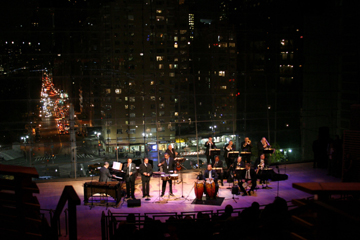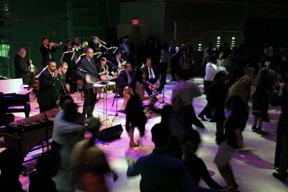
(845) 246-6944
· info@ArtTimesJournal.com
By
Dawn Lille
 The Tito Puente Band at the Allen Room, at Jazz at Lincoln Center, NYC |
Mambo, the Cuban
music/dance that achieved a fever pitch of popularity in the 50’s, referred
to as “mambomania,” is being given a big push to regain popularity and
stardom by both old timers and young, non-Latino dancers. A recent concert
at Jazz at Lincoln Center called “Palladium Memories” was further described
as “A Night of Dancing Celebrating the Palladium Mambo Big Band Era.” It featured the Tito Puente Band, demonstrations
by established professional ballroom dancers and a dance floor in front
of the orchestra, all backed by the floor to ceiling windows and beautiful
view of the Allen Room. This
wonderful space was filled with the dancing audience, who were invited
to move with every note. As Felipe Luciano, the MC, said, it was not a
time for nostalgia, but of regeneration of a music culture that demanded
simultaneous movement
Mambo
is both a musical style and a dance form that shows the converging influences
of Africa, Europe and quintessential Cuban jazz. Historically, the culture
of the African Haitian settlers in Cuba joined with the country dances
brought by the Europeans, to which was added a syncopation called cinquille.
One of the many resulting forms was the son, a mixture of African and
Spanish elements, often called danzon, which was a song as well.
 Delille Thomas and his Partner in Performance at Allen Room, at Jazz at Lincoln Center, NYC |
In
1937 Orestes and Cachao Lopez, the latter a bassist and composer, wrote
a danzon called “Mambo.” The
dancing equivalent was introduced in 1943 by Perez Prado, a black Cuban
bandleader at the nightclub La Tropicana on the outskirts of Havana. Prado
took the rhythm of the sugar cane cutter and incorporated the cinquille
syncopation, creating a slightly jagged or staccato effect.
He came up with the idea of a specific dance to the music and was
the first to advertise the entire experience as “Mambo”. Among the bandleaders
who copied it and developed their own styles of what became a fusion of
Cuban jazz and American swing were Xavier Cugat and Tito Puente.
Tito
Puente (1923-2000) was a Harlem born Puerto Rican composer, arranger and
percussionist who received four Grammy awards and whose popularity extended
to the David Letterman Show. He attended Juilliard where he studied composition,
orchestration and conducting. In 1948 he formed his first band, the Picadilly
Boys. With a large Anglo and Hispanic following, a 1956 poll elected him
“King of Mambo.” Puente always said he was really a dancer and had to
dance in the studio to see if the music on his recordings worked.
The
band that still bears his name has eleven musicians, some of whom have
been with the group for forty years. The instruments include the saxophone,
flute, bongos, timbales, keyboard, trombone, trumpet, congo, vibraphone
and bass. The group is led by Jose Madera, its musical director.
The
Mambo resembles the rhumba (also Cuban). It is in 4/4 time with an emphasis
on counts 2 and 4, but many native Cubans will break or emphasize any
beat. Additionally, the danced mambo usually has a beat in every bar that
is a rest, during which the dancer does not take a step. Sometimes the
dance phrase extends over two bars, with the dancer choosing to remain
still on count 5 and/or to introduce syncopation at will. It is a very
sensual dance and, in its choreographed versions, very complicated.
 The Tito Puente Band and dancers at the Allen Room, at Jazz at Lincoln Center, NYC |
Mambo
was first seen in the United States at the Park Plaza Ballroom in New
York City, but became a major dance when it appeared at the Palladium
Ballroom in 1947 and evolved into the dance craze of the 50’s. The Palladium
became the “temple of mambo” with such dancers as “Killer Joe” Piro, Augie
and Margo Rodriguez and Pedro “Killer Pete” Machito, who gave demonstrations.
They added an expressive, curling use of arms, legs, hands and head to
the original dance. Classes were also given. Thus, all who came could
learn, feel comfortable and add their own embellishments.
One
of my party in the Allen Room spent years going to the Palladium, which
was on Broadway in the lower 50’s and literally “jumped.” Everyone was
welcome and Wednesday was acknowledged as the “big” night. Some came in
couples, but most went in a group. There were tables where waiters served
customers and people with birthdays had cakes. The Joe Valle band was
in residence for years; in addition to the mambo, he was a specialist
in singing the bolero, a slower ballad.
There
were two clubs in the Bronx, one of which was the Tropicana, and in the
other boroughs as well. Another popular one in Manhattan, in addition
to The China Doll and Birdland, was Caborojena on Broadway and 145th
Street. This attracted mostly Latinos. A woman who was collecting contact
information in the Allen Room told us her parents had met there; her father
walked in and saw her mother dancing on a table.
Much
of the current resurgence of the mambo can be credited to Eddie Torres,
a professional ballroom dancer and teacher and a self-proclaimed post-Palladium
mambo fanatic, who performed with Tito Puente. He originally learned to
dance during the second wave of the mambo craze in the 60’s and 70’s.
Then, at the Hunts Point Palace in the Bronx, young dancers could come
from noon to midnight for five dollars and participate in dance and pie
eating contests. He credits his real knowledge of the mambo to an older
professional ballroom dancer named June Laberta, who forced him to learn
the theory behind the music, thus enabling him to choreograph. He says
the “hottest” club in the 70’s was Tony Ramon’s Corso, where Puente was
among the featured bands.
Torres
and his wife Maria started the evening by offering a brief class in mambo
technique, which he taught with great clarity. He and Maria were also
among the demonstrators in a style that was soft, flowing and quiet in
its rhythmic complexity, but included fast turns and circles around the
floor. Delille Thomas, a mambo dancer and choreographer who has appeared
internationally and was part of the 1996 Summer Olympics, performed with
a partner. His smooth, effortless dancing seemed related to the old soft
shoe and one could almost feel the Haitian influence in his style. Another
dancer was Freddie Rios, one part of a group called Cha Cha Aces. His
clear quick steps brought to mind some outstanding tap dancer.
In
watching the couples on the dance floor, it was easy to spot the older
ones, some of them from the Palladium era, because of their quiet, understated
style. The younger dancers, many in number, had obviously taken classes
and were adding the circling arms and more complicated breaks.
Ron
McGugins, the producer and mastermind behind this first mambo evening,
has great hopes of returning this dance gift to the city. He plans another
such party in the Spring. Come and enjoy!